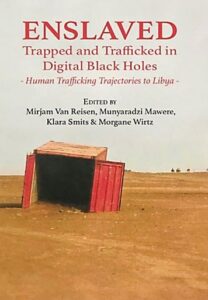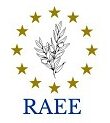Editors: Mirjam van Reisen, Munyaradzi Maware, Klara Smits, and Morgane Wirtz
Year: 2023
Publisher: Langaa RPCIG, Cameroon
Language: English
ISBN: 10
Pages: 791

Eritrean refugees are being trafficked and enslaved in Libya, where they are tortured to force relatives to pay a ransom for their release. Labelled with a digital code, they are moved along in the possession of the traffickers through a series of ‘black holes’, in which their access to digital technologies and connectivity is highly controlled. They are tortured, abused, extorted and subjected to sexual violence. Many die along the way. If they make it to the Mediterranean Sea, they risk being intercepted and returned to Libya or dying at sea.
Over the period of this study (2017–2021), it is conservatively estimated that at least two-hundred thousand – men, women and children – have fallen victim to human trafficking for ransom in Libya, and the cumulative value of this trade for that period is estimated at over 1 billion USD.
This detailed ethnographic study identifies the routes, modus operandi, organisation, and key actors involved in the human trafficking for ransom of refugees and migrants, who are desperately in need of protection. The book is part of the GAIC Research Network and African studies series published by Langaa RPCIG and makes an important contribution to the literature on human trafficking, migration studies, African studies, modern slavery, social protection and governance.
Book Chapters
- Preface by Honourable Chief Fortune Charumbira
- Chapter 1: Human Trafficking for Ransom in Black Holes in the Digital Landscape: An Introduction by Mirjam Van Reisen, Munyaradzi Mawere, Klara Smits, Morgane Wirtz
- Chapter 2: Living in a Black Hole: Explaining Human Trafficking for Ransom in Migration by Mirjam Van Reisen, Klara Smits, Morgane Wirtz & Anouk Smeets
- Chapter 3: Skin in the Game: Methodology of an Ethnographic Research with Exposure to Trauma by Mirjam Van Reisen, Klara Smits, Morgane Wirtz, & Bruna Mikami
- Chapter 4: Human Trafficking for Ransom: A Literature Review by Eva Lorger & Piet Gotlieb
- Chapter 5: The Past is not Past: The History and Context of Human Trafficking for Ransom in Libya by Morgane Wirtz, Dion Ferdi de Vries & Mirjam Van Reisen
- Chapter 6: Enslaved by their Own Government: Indefinite National Service in Eritrea by Sara Palacios-Arapiles
- Chapter 7: Escaping Eritrea: The Vulnerability of Eritreans to Human Trafficking by Klara Smits & Morgane Wirtz
- Chapter 8: TRUST Works: Delivering Trauma Recovery Understanding Self-Help Therapy (TRUST) to Refugees from Eritrea by Selam Kidane
- Chapter 9: Deceived and Exploited: Classifying the Practice as Human Trafficking by Klara Smits & Mirjam Van Reisen
- Chapter 10: Straight Lines in the Sahara: Mapping the Human Trafficking Routes and Hubs through Libya by Morgane Wirtz
- Chapter 11: “You are the Ball – They are the Players”: The Human Traffickers of Eritreans in Libya by Klara Smits
- Chapter 12: Living Skeletons: The Spread of Human Trafficking for Ransom to Libya by Morgane Wirtz & Mirjam Van Reisen
- Chapter 13: Hell on Earth: Conditions of Eritrean Refugees in Official Detention Centres in Libya by Morgane Wirtz & Mirjam Van Reisen
- Chapter 14: “Dead-dead”: Trapped in the Human Trafficking Cycle in Libya by Klara Smits
- Chapter 15: “We had no Choice; it’s Part of the Journey”: A Culture of Sexual Violence in Libya by Morgane Wirtz
- Chapter 16: “Gate Closed”: The Situation in Libya during COVID-19 by Morgane Wirtz, Klara Smits & Mirjam Van Reisen
- Chapter 17: Active Agency, Access and Power: Social Media and Eritrean Refugees in Libya by Sara Creta
